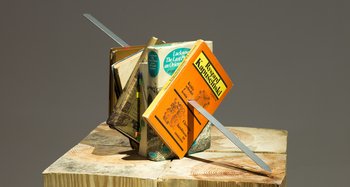Invitation to a press conference | Slavs & Tatars. Made in Dschermany
24 May 2018Slavs & Tatars. Made in Dschermany
Dschingis Kahn? Dschebel? Dschunk food? Dschin and tonic? The Slavs and Tatars collective takes the idea of art as translation absolutely literal. In their Dresden survey exhibition “Slavs & Tatars. Made in Dschermany” the artists focus on language and its ambiguity, examining, among other things, the tetragraph “dsch” which, in German, is mainly used to represent the “j” sound in foreign words. Just like this foreign sequence of letters is added to the word “Dschermany”, visitors are invited to explore the individual in the foreign and the foreign in the individual, to open their minds and engage with the Slavs and Tatars way of thinking.
- Exhibition Site Kunsthalle im Lipsiusbau
- Dates 02/06/2018—14/10/2018
[Translate to English:] Slavs 2

[Translate to English:] Slavs 2
From the start of June 2018, the Albertinum, run by Staatliche Kunstsammlungen Dresden, will be presenting the largest exhibition of the artist collective’s works in Germany to date. Large-format installations, works of sound, sculpture, videos and wall hangings all untiringly revolve around the topic of language. Language – how it begins, develops, is used; its shape and shapelessness, its emotional and political role – is a central impetus for the artists’ extensive works. This can be seen clearly in the collective’s many publications, in which Slavs and Tatars develop their ideas. These thoughts are then staged and discussed in the form of lecture performances which accompany the collection, presented by the artists themselves.
In their works, the artists’ collective, which grew out of a book club in 2006 in Berlin, tackle traditions and customs, language, history, anthropology, philosophy and politics. Their artistic and discursive pieces always also revolve around examining belief and intercultural understanding. The artists describe themselves as “a faction of polemics and intimacies devoted to an area east of the former Berlin Wall and west of the Great Wall of China, known as Eurasia”. Both (socio )geographically and culturo-historically, Slavs and Tatars thus move within a colossal space, which represents the source of their knowledge. The collective’s research is complemented and brought into a different context by playfully incorporating contemporary culture and blending together different religious and philosophical teachings: a syncretism which winds its way as a common theme through many of their works.
Alongside the presentation in the Lipsiusbau, other pieces by the artists’ collective can also be found in the SKD’s Albertinum, Porzellansammlung and Mathematisch-Physikalischer Salon. An extensive programme of supporting events includes the group’s artistic practices being presented on guided tours or the public being invited to discussions with academics, and a one-day symposium “Sum, ergo cogito”.
The artists’ book “Wripped Scripped” accompanies the exhibition, jointly published by the Albertinum and Kunstverein Hannover: content by Slavs and Tatars, design by Stan de Natris / Slavs and Tatars, Hatje Cantz Verlag, 152 pages, 200 plates, €30, ISBN 978-3-7757-4472-0.
The SKD will communicate on social media with the hashtags #slavsandtatars, #madeindschermany, #albertinum and #skdmuseum on social media.
